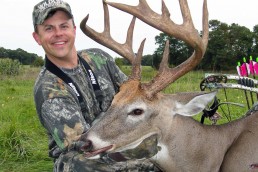Worthy of the Stand: Managing Perennials in the Midwest
SHARE THIS POST
If you live north of the Mason-Dixon Line and mange your property for whitetails or turkeys with attraction and nutrition as your goal, a perennial clover blend should be on your menu. Many consider clover to be the cornerstone of a sound food plot program. Those in the South may also plant clover, but the cooler, humid-growing season in the North favors these legumes.
White clover is a perennial legume (some are annuals) that can provide years of quality, high-protein, attractive forage for your herd. Red clover tends to be a bit easier to grow in a wider range of conditions. However, they are typically not as attractive to whitetails as most of the white varieties of clover.
The best products for most food plot farmers will be a “blend” of several different clovers and possibly other perennials like alfalfa, trefoils and chicory. With a blend, you not only supply your herd a wider array of choices and significantly increase the palatability timeframe of the stand, but you also protect yourself against failure due to specific growing conditions unfavorable to a cultivar.
When maintained properly and planted in soil, which is initially close to a neutral pH level, perennial clover blends can produce for six to eight years or even more. In more acidic soils and due to the need to incorporate lime, and depending on your soil type and original pH, you can expect more like three to five years from your crop and then you’ll need to incorporate lime once again.
White clover will spread by sending out stolons, a stem that grows horizontally along the ground’s surface. The stolon will create nodes, a joint on a plant stem where a leaf attaches, where roots will form. This process creates “daughter plants,” which will replace the initial seedlings within a few years. So perseverance is highest in the varieties that create the most stolons, which is typically the small-leaved white clover.
Renewal from seed is also possible. If the plants are not browsed heavily or mowed often they will flower and produce seed. Regeneration from seed helps longevity in areas with dry summer conditions.
Large-leaved types (Non-typical or Ladino) perform best when they are mowed less frequently, or when browsing pressure is limited and plants are allowed to mature. On the other hand, the small-leaved types respond better to frequent browsing and/or mowing. Large-leaved types have fewer stolons and typically do not regenerate or persist as long as medium- and small-leaved white clover and are more apt to be detached by browse pressure.
Unless you are confident in your specific conditions, I recommend a blend of large-, medium- and small-leaved white clover along with red clover, alfalfa and chicory. The advantage of establishing a blend is the plant that is best suited to the growing conditions and management style will emerge to the forefront and endure the longest and the strongest.
Soil fertility and pH
Soil pH has a profound effect on the availability of nutrients to plants and microorganisms. The basic macronutrients (calcium, magnesium, sodium and potassium) are usually found only in low amounts in acid soils and are most readily available in neutral or alkaline soils. Micronutrients, iron, copper, manganese and zinc, are highly soluble and readily taken up by the plants, even at a low pH, but in these acidic soils some of the nutrients can be present at levels toxic to clover.
To maximize white clover growth and nitrogen fixation in low-fertility soils, large amounts of phosphate fertilizer is usually required along with enough lime to balance the pH, along with sulfur and potassium. Phosphorus is an important nutrient for the development of a vigorous root system, and a phosphorus deficiency may affect the plant’s uptake of other nutrients.
Are you enjoying this post?
You can be among the first to get the latest info on where to go, what to use and how to use it!
Seasonal production and management
During spring, white clover plant populations are fragile and susceptible to mismanagement and environmental stresses. Food plot farmers see large leaves develop on the plants if the plots are not mowed; they believe this to be a “good thing.” Actually, not mowing the plots can be damaging to the plants. Not mowing as frequently allows the development of larger plant leaves, but it also has a negative effect on the structure of plants in decreased leaves, stolons and roots produced. By not frequently mowing, the stand will not be as productive or healthy in the future.
The frequency and intensity of mowing can noticeably influence the white clover plant population. Frequent mowing during spring favors white clover, allowing light to penetrate the base of the clover, which in turn encourages stolon development.
Besides the frequency of mowing, another aspect of white clover maintenance is the level of defoliation—how much of the plant’s height is removed during mowing. The interaction between mowing frequency and severity has a significant effect on the size of individual plant organs and the survival rates. Infrequent, aggressive mowing during spring will allow development of larger leaves and tillers, however this results in the death or disappearance of many new plants. Increasing the frequency of mowing decreases the time available for full growth of leaves, while the plant density and total tonnage of leaves produced increases. It also helps control most weeds and ensures new, succulent growth is available that wildlife prefer.
It should be known that this pattern of frequent mowing for improving plant community vigor should be reconsidered during summer. Once soil moisture levels decrease, overgrazing or mowing can be detrimental to the stand. During hot or dry conditions, white clovers should not be mowed frequently and should even in some cases be left unmowed long enough to produce seed heads.
With a perennial white clover stand, persistence can be promoted both through frequent mowing during the spring to increase stolon production and no mowing during droughts or when the clover is growing slow to promote seed production.
In a blend like Clover Plus, you have a mixture of tall-, medium- and short-growing white clover. With this mixture, the plant variety that performs best in each specific location will eventually dominate the stand; the best-adapted species eventually spreads and thrives. In addition to the different varieties of white clover, perennial red clover increases production during the drier conditions of summer. With its ability to withstand drought, chicory has also been added, addressing the August and September dry periods common in the East.
A soil test should be done to ensure the correct nutrients are applied. A blend with no nitrogen is typically recommended. Legumes produce their own nitrogen—if you add nitrogen to legumes you encourage other grasses and unwanted weeds to take root and you “train” your clover to be lazy and stops affixing its own. I will usually use something similar to about 250 to 300 pounds of a 0-20-20 ratio per acre in the spring and then 200 pounds of 0-0-60 in mid-August. Besides helping with other aspects, I’m a believer that the potassium applied during late summer helps significantly with cold tolerance.
It is likely that you’ll need to treat your plot with a grass herbicide from time to time. Clethodim and sethoxydim are the two most popular active ingredients in most grass herbicides. I prefer the clethodim products; Select, Arrest or Volunteer brands are examples. Treat about 10 days after mowing the field, or during the spring when daytime highs are in the 70s, but before the grass reaches 8 to 10 inches tall. Poast would be the most popular sethoxydim brand, but I prefer the clethodim-based products.
White clover maintenance is not that complicated. Mow it frequently during the cooler spring months, but during hot or dry weather, do not mow as often, or at all. During dry conditions, white clover should be allowed to produce seed heads. White clover stands are most beneficial to wildlife when they persist for many years and provide forage without requiring the manager to reestablish the stand often.
MWO
SHARE THIS POST
Did you enjoy this post?
You can be among the first to get the latest info on where to go, what to use and how to use it!
Todd Amenrud
Todd Amenrud is a full time sportsman whose passion is bowhunting whitetails. He spends considerable time researching whitetails, and has written six books on the subject. Harvesting 47 record-book animals and his ability to share his knowledge have made him one of the Midwest’s most-recognized hunting resources.



